Which Of The Following Is Not A Type Of Mobile Ad Extension
- AdWords •
- PPC •
Ana Gotter • January 31, 2019
Here at Disruptive Advertising, we talk a lot about how to make your PPC campaigns more efficient. We have resources on everything from using the right bidding strategies to copywriting tips to keyword research, all here to help you improve the ROI you're seeing on every campaign you run.
There's a lot that goes into creating a high-performing ad, but what would you say if I told you that I could show you one quick secret that could reliably help you increase your campaigns' CTRs, conversion rates, and possible both the ad rank and quality score all at once?
On board yet? Excellent, because this secret is easy to execute, and since so many advertisers aren't using it, it'll give you an immediate edge. And the secretis simple: all you have to do is add Google Ad extensions to your campaigns.
In this post, we're going to go discuss everything you need to know about Google Ad extensions so that you can start using them right away, including how to create extensions, the different types you can choose from, and how to use them.
What are Google Ad Extensions?
Google ad extensions are essentially snippets of additional information that you can add to your campaigns to make them more effective. There are plenty of types of ad extensions, and each one offers distinct advantages by providing information or clickable CTAs that can improve the performance of your ad campaigns in some way.


Since Google Ad campaigns have such limited character counts, the appeal of being able to add more content and increase the information you can share is easy to understand. The extensions literally add more real estate to your ad campaign, and the more information you can use to sway users to take action, the better.
The "more room" part is key to increasing click-through rates and conversion rates. Not only will your ad stand out more in the feed, it will also contain more useful info that can show users what they're looking for quickly and pique their interest. According to Google, a quick Site Link extension can increase CTR by up to 15%.
While some extensions are effective because they offer more information that answers a user's question, some contain clickable CTAs that make it easier for the user to get where they want to go. A call extension, for example, allows you to add a phone number to your ad, which is clickable on mobile for easy access and making the ad more effective.
There are also no drawbacks to using extensions. They don't cost anything extra, and they won't have a negative impact on your campaigns. Instead, the additional information in the ad could increase your quality score, and thus your ad rank.
How to Create Ad Extensions
Google Ads extensions can be created during the ad creation process, or separately through the Ads Manager, whichever you prefer. Each one only takes a few minutes to set up, as they'll have templates available that you simply need to fill out.
To create extensions through the Google dashboard, find "Ads and Extensions" and then click over to "Extensions." You'll see a list of the different types of extensions you can choose from, so click on the "Create" button to get started.
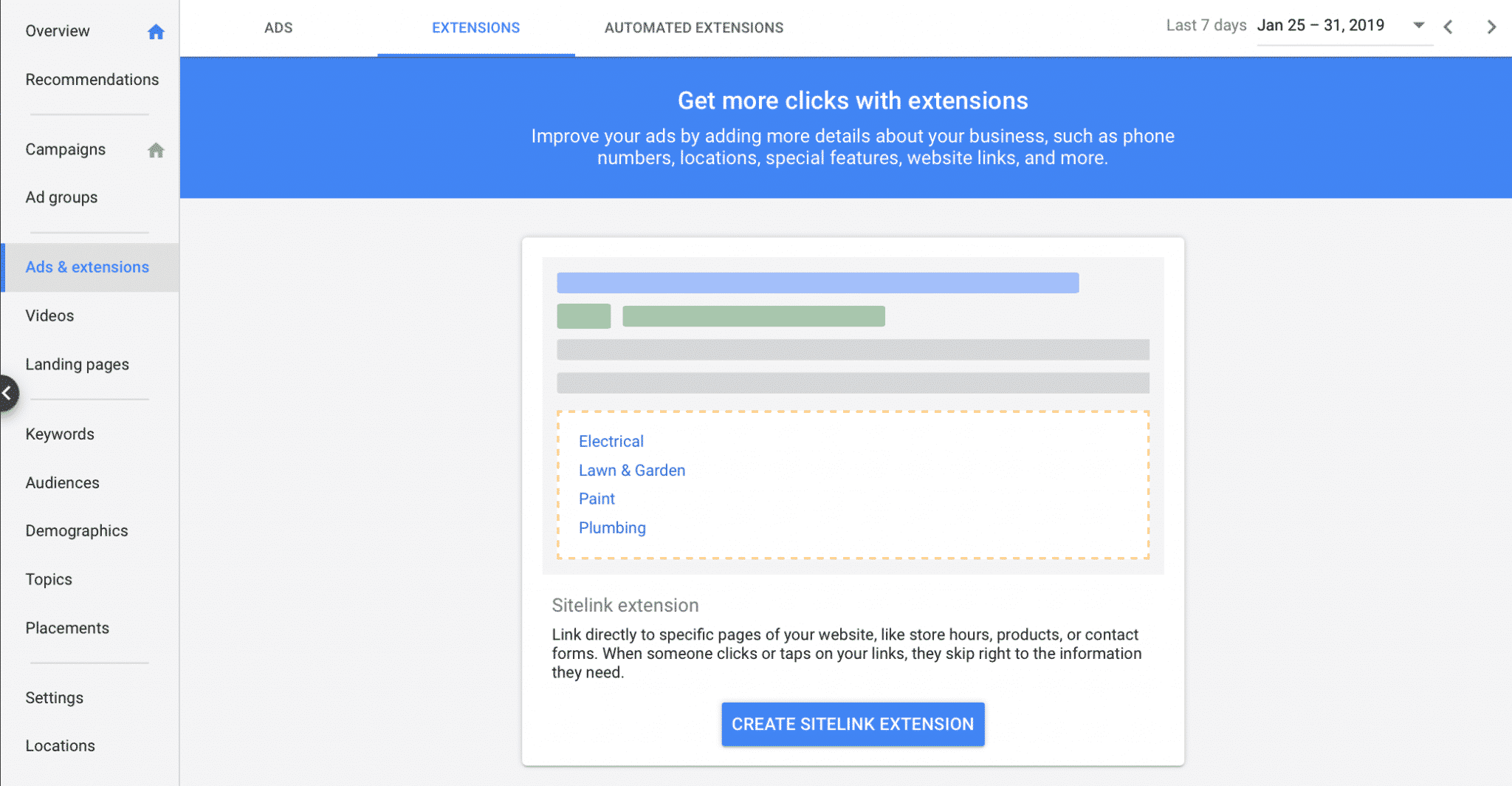
Each extension type will require you to enter in different information, but many will allow you to enter in descriptions and even URLs. Fill out each field that you can with crucial information, even if it's optional, so that you can make the most out of the extension.
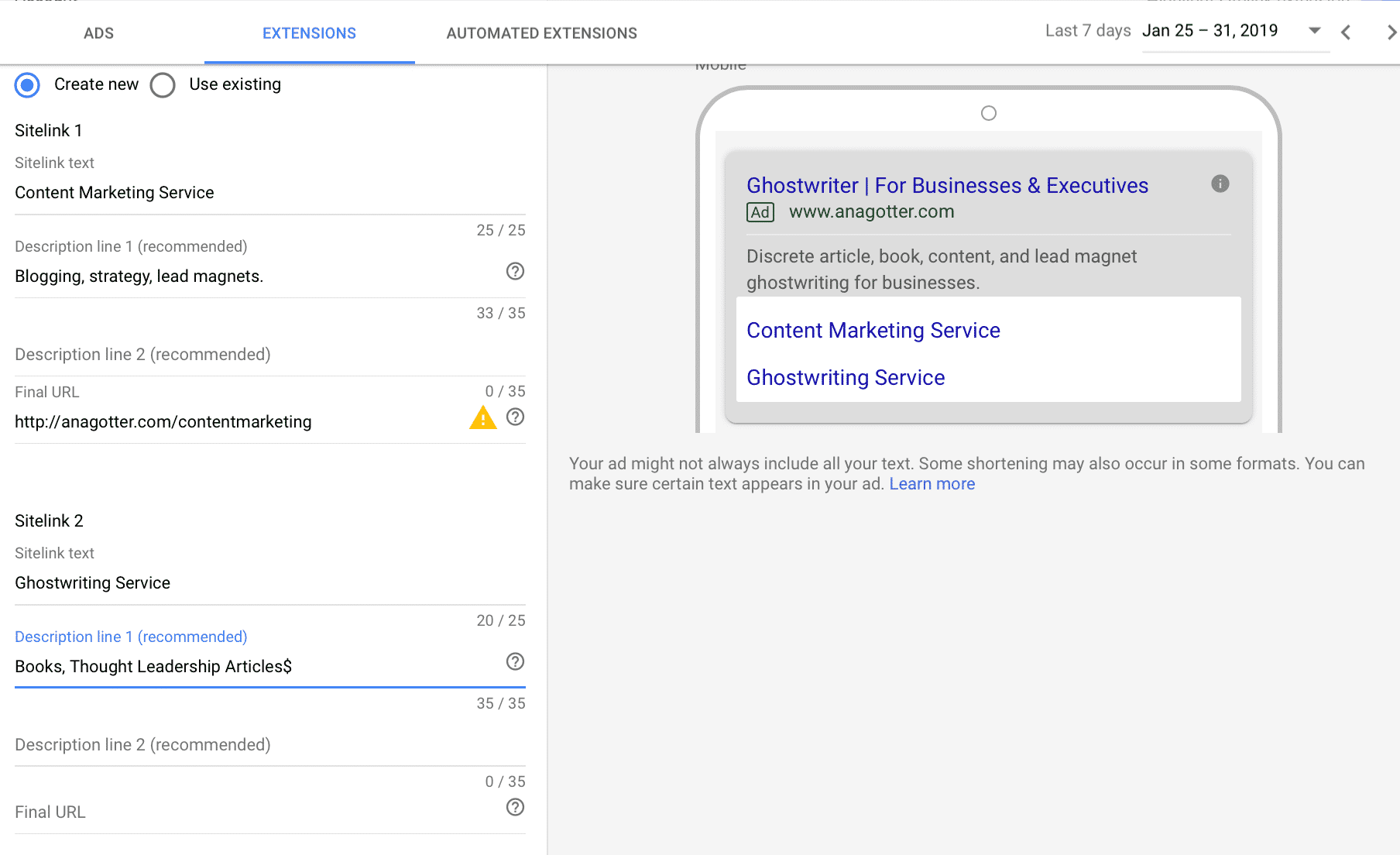
When creating different extensions, you'll see the "Advanced Options" tab at the bottom of the page. These options let you customize who is seeing the extension and when. You can choose to enable mobile-only visibility (which may work for a call extension), or establish a schedule like you're dayparting the extensions only. The scheduling may work if you want to limit actions or information, like having an extension featuring sales prices when the sale itself is over.
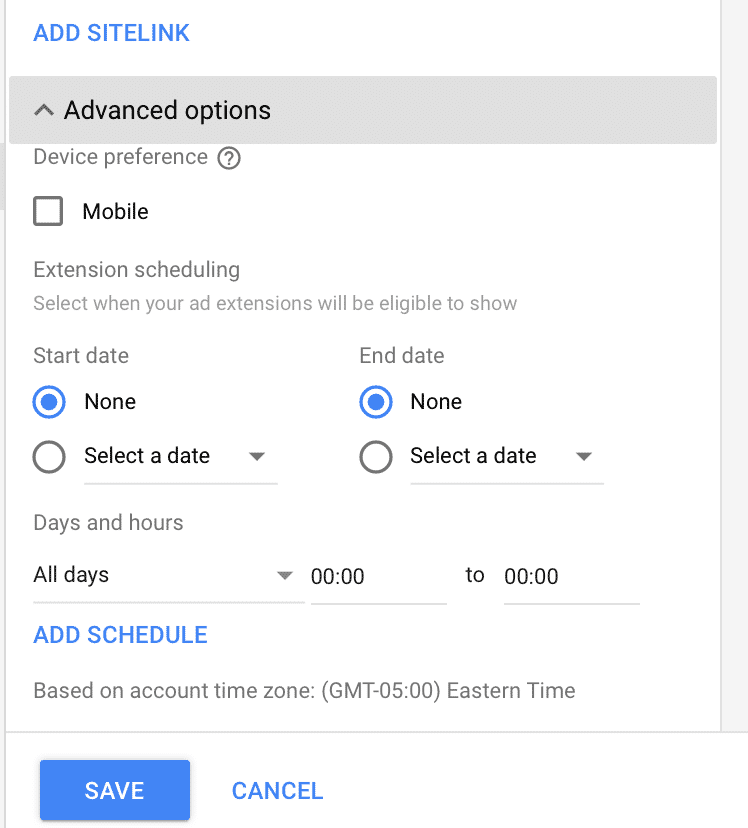
Most extensions, however, won't need the advanced options, so don't feel like you have to use them unless it would actually benefit your ad campaign.
How to Add Extensions to Your Campaign
More good news: it's not only easy to create extensions, it's also easy to add them to your campaigns.
During the ad creation process, you'll see the "Ad Extensions" option at the very bottom of the first stage where you create the campaign itself.
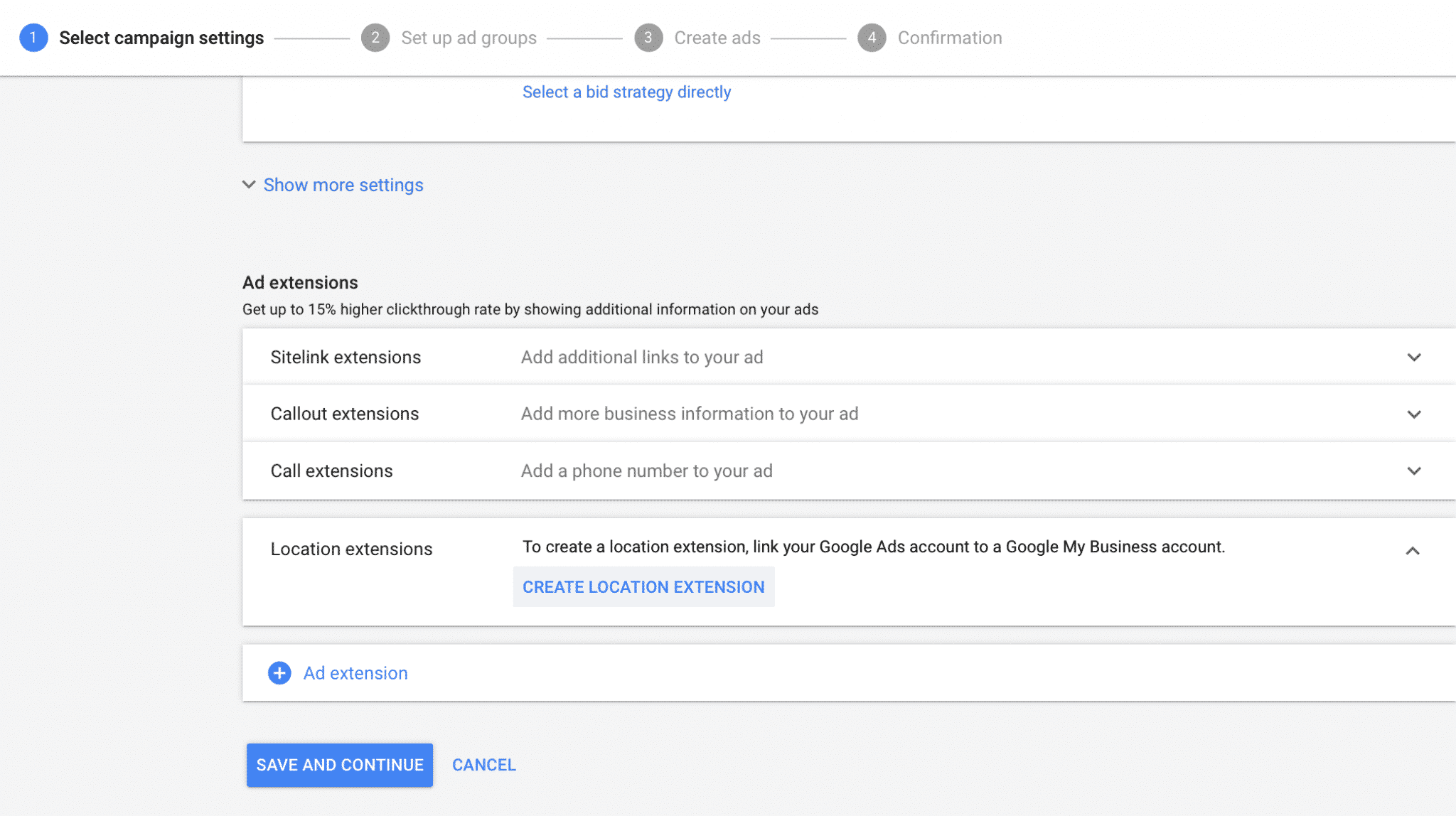
When you click on the extension that you want to use, you can choose from an extension that's already been set up, or create a new one. Google will show you a preview, and you can continue on to create the ad as you normally would.
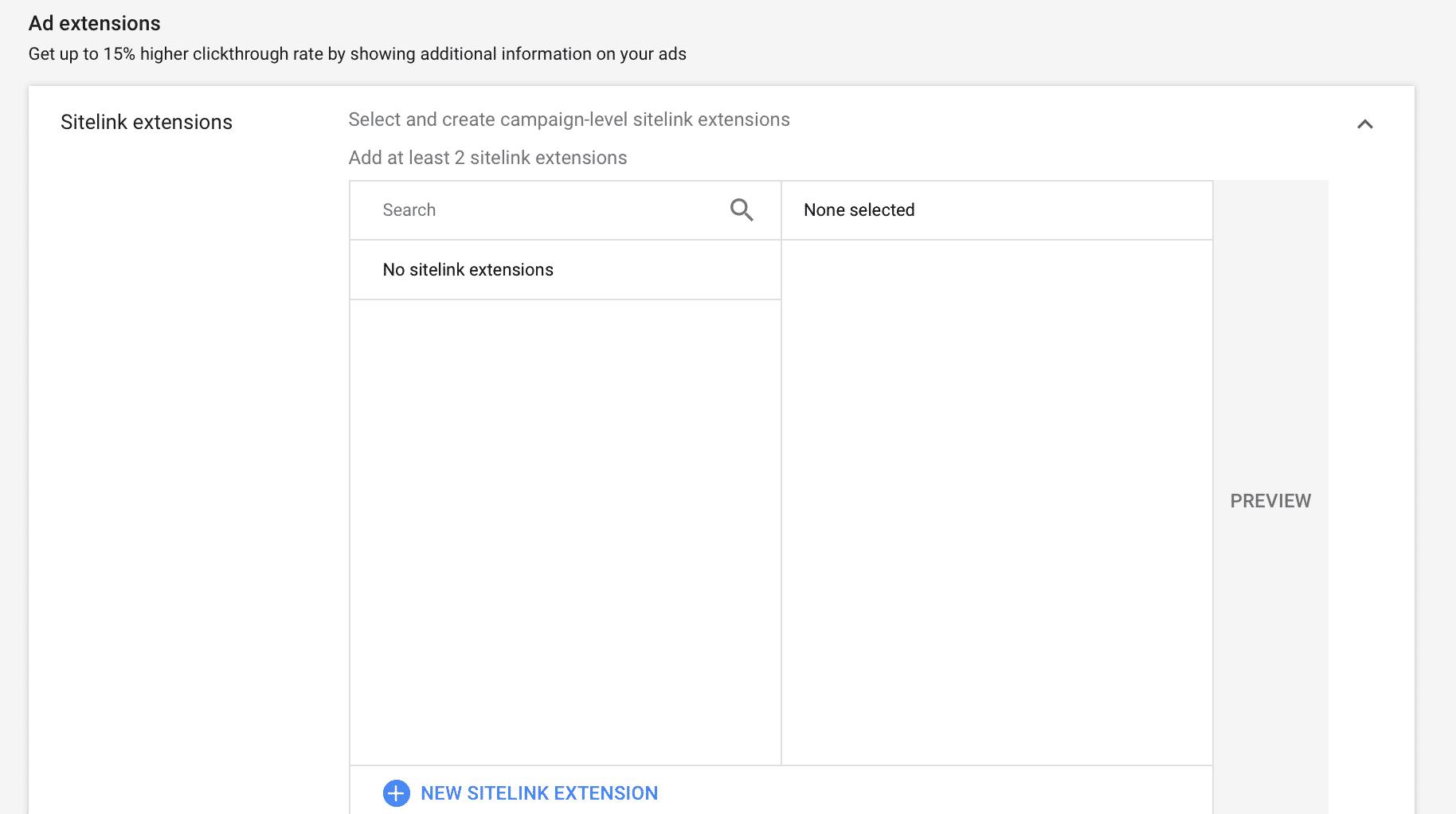
The 7 Most Effective Google Ad Extensions and When to Use Them
There are a number of different extensions that you can use to increase the effectiveness of your ad campaigns, and the key to seeing those higher CTRs and conversion rates is to know which ones to use when. You can use multiple extensions on any given campaign, which helps with the decision process.
Let's take a look at the 7 best extensions you can use and how and when you should be using them.
1. Sitelink Extensions
Sitelink extensions are one of the most frequently used types of ad extensions. They allow you to add short snippets of information that essentially act as CTAs, which when clicked will take users to key pages of the company's site.
In the example below, the ad features links to key pages that will help get searchers where they need to go. Some, for example, will want to look the law team over and get a quick look at their experience, others will want to see testimonials to establish trust, and others still will see "Facing Criminal Charges?" and immediately think "YES!" while they click.
Sitelink extensions can be used for almost any ad campaign. When used for campaigns designed to attract users early in the buying cycle, they should contain links to introductory information, like "About Us" pages and information on key products or services. Use them to show users the information they're most likely to look for when making a purchasing decision and highlight what makes you different.
The only time you definitely shouldn't use a site link extension? When you have a single-page website.
2. Call Extensions
Call extensions are another popular one, and they work by featuring your business's phone number at the top of the ad, next to the site URL. On desktop, this will just show up as a phone number that users can enter in to a mobile device; on mobile, this number is actually clickable, and with only two taps someone can be calling your office.

Call extensions are a good choice if you have the bandwidth to handle an influx of calls from people who need appointments, reservations, consultations, or even just answers to quick questions like "can you make that gluten free?" They don't take up a lot of space, and it's always better to have it for the client if they need it than not. Remember, convenience is a huge asset when people are in a hurry, and mobile users typically are.
Mobile searchers, after all, have an immediate, right-now need. They're looking for something they need urgently, and having this extension or location extensions (which we'll look at soon) can actually be the deciding factor of whether or not they come to see you or your competition.
The only time not to use this extension? If you don't actually want unscheduled phone calls. Consultants and freelancers like myself typically don't just pick up the phone every time it rings; instead, we set up scheduled consultations, so having our phone number listed online wouldn't be the way to go.
3. Call Out Extensions
Call out extensions are a little different from other options on the list, and they're a somewhat newer type of extension. They create CTAs within your ad, but they're not clickable. Instead, they simply work by giving you more room for information you want to share in the ad itself.

In the above example, "Free Moving Quotes," "24/7 Live Support," and "Long Distance Moving" are call outs that you might add in. You get 25 characters for each individual call out, which gives you valuable real estate that you can use to share important, click-winning information.
These extensions are most frequently used to concisely highlight benefits of the products or services you're advertising, like "Free moving quotes" above. These quick call outs can provide the information needed to differentiate you from your competition, so don't write them off just because they aren't hyperlinked.
That being said, if you're able to convey the value of your brand or your offer in the ad as it stands and there isn't a need to add more, skip this one and rely on other extensions instead.
4. Structured Snippet Extensions
Structured snippet extensions are a personal favorite, because they really capture your attention as a user, which can mean more clicks for you as an advertiser. Structured snippets allow you to create hyperlinked, clickable headlines that send users to key pages on your site, and feature a quick description under each one.
These are, essentially, like sitelinks on crack. They're more noticeable, and the additional information under each link will increase the likelihood of relevant clicks. Use the text to explain what makes you different and the value each page has. The example above features links to different categories of ecommerce products, but you can also feature "About Us" or "Testimonial" pages just like you would with the sitelink extensions.
Typically it's going to be best to choose either site link extensions or structured snippet extensions. Decide what will work best for your ad campaign and then go from there.
5. Location Extension
Location extensions are another option that are pretty much exactly what they sound like, and they add your business's address to the bottom of the ad, along with your operational hours if you feature it. When users click, they'll be taken to a Google map showing your location, and they can instantly get directions to where you are.

Location extensions are an excellent choice if you have a brick-and-mortar location where you actually serve clients. They're an essential choice if geographic location will heavily influence whether or not someone decides to do business from you. A marketing consultant may not need this, even if they have a physical location; a hair salon, however, definitely would.
6. Price Extension
Price extensions allow you to quickly showcase how much a given product or service costs, listing an item, linking to it's specific URL, and then featuring pricing and qualifying information.

This is a great opportunity to make your ad even more competitive by offering up highly relevant information up front. Price, after all, is a huge factor that can shape someone's buying decision. The transparency of having the price readily available up front can increase clicks if you're within the range that the searcher is looking for, and get them to click on your ad instead of a competitors'. It's better to start with what you know instead of what you don't, after all.
And if the price is out of range from what the searcher is looking for? That's ok, too, because you don't want to pay a lot for clicks that have no chance of conversion. This extension can actually prevent that.
Price extensions can work well when you want to feature a few key products or services in particular; they may not work well for ecommerce stores with diverse items that come with extensive differences in cost, but they can be particularly valuable if your low cost is a selling point.
7. App Extension
Have a mobile app? If you do, it's likely because you know that users spend 90% of their mobile time within apps, so you know that having one for your business is key to staying relevant and increasing engagement with your audience. So don't wait for users to find that app on their own, and use the app extension to boost its visibility.
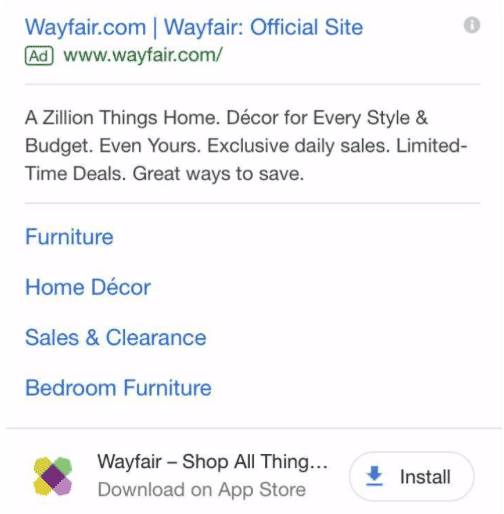
App extensions are mobile-only extensions, and they'll feature the name and logo of your app next to a clickable "Install" CTA at the bottom of your ad. These extensions are created to convince users to download your app, offering a new way for you to keep them engaged. Since it's mobile-only, this will make the extension incredibly valuable for users who may not want to navigate a full site to begin with.
If you have an app, use this extension to promote it always. There is no downside here.
Conclusion
Google Ad extensions are an all-win, no-lose situation. They don't cost you anything extra and there is no evidence that they can do anything but improve your campaigns. By increasing the amount of space your ad takes up, giving it more visibility, and allowing it to provide more relevant information to your target audience, they're truly valuable resources that you should use on each of your campaigns.
If you're struggling to choose which ad extension(s) you want to include on a given campaign, keep the following in mind:
- You can add multiple extensions to each campaign.
- If the extension will help you drive the specific goal you want to accomplish by making information more easily available to your audience, use it.
- Don't include extensions aren't immediately relevant to your audience. Think a small business who doesn't take phone calls, they probably shouldn't be using that call extension.
- If you're really stumped, you can always run A/B tests on your ad campaigns. Run one campaign with certain extensions, and then ad different ones to another, so you can see if any are driving actions or not.
Want some assistance choosing which extensions you should ad to your campaigns and how to optimize them? We offer full PPC campaign management. Send us a message and find out how we can help you.
What do you think? Do you use Google Ad extensions to improve the your click-through rates and conversion rates? Which extensions are your go-to picks? What results have you seen by using them? Share your thoughts, knowledge, and questions in the comments below!
Leave a comment
Which Of The Following Is Not A Type Of Mobile Ad Extension
Source: https://disruptiveadvertising.com/adwords/ad-extensions/
Posted by: valdeztherplis.blogspot.com


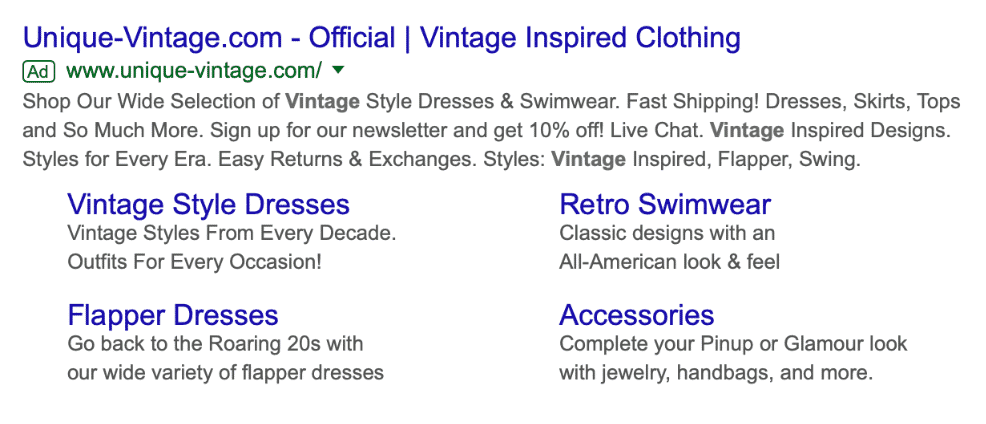
0 Response to "Which Of The Following Is Not A Type Of Mobile Ad Extension"
Post a Comment